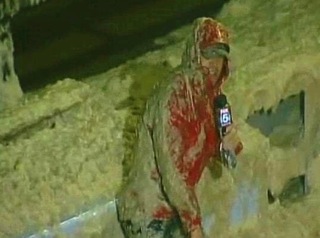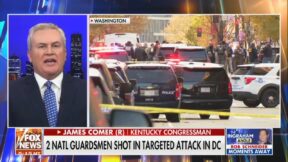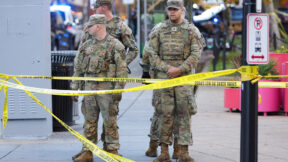Don’t Believe The ‘Media Hype’ Hype: Howard Kurtz Wrong On Irene Coverage
 The only thing more predictable than the swallows return to Capistrano is the very use of the Capistrano swallows as banal trend metaphor in a media criticism piece. But a close second in the growing list of media criticism cliché is the post-event hand-wringing alleging overwrought news coverage. Case in point, the Monday morning quarterbacking done by many media critics’ breathlessly taking news outlets to task for ostensibly over-hyping the potential effects of Hurricane Irene.
The only thing more predictable than the swallows return to Capistrano is the very use of the Capistrano swallows as banal trend metaphor in a media criticism piece. But a close second in the growing list of media criticism cliché is the post-event hand-wringing alleging overwrought news coverage. Case in point, the Monday morning quarterbacking done by many media critics’ breathlessly taking news outlets to task for ostensibly over-hyping the potential effects of Hurricane Irene.
First, some basic facts: roughly 65 million U.S. citizens live in what meteorologists correctly predicted to be Hurricane’s path of landfall on the East Coast. Starting roughly Wednesday of last week, elected officials began issuing warnings of the potential danger of the looming Hurricane, which worked itself to a fever pitch on Friday, culminating with New York City Mayor Michael Bloomberg issuing a mandatory evacuation warning to city residents living in the areas most in danger. Along the way, it was reasonably reported that the real danger with the Hurricane was not necessarily the high winds, but rather the flooding that would result from the storm surge and high tide. As the politicians ratcheted up their rhetoric, many in the media reported on the dire warnings, and yes, in some cases, amplified what was being said. But was it responsible reporting? Or “scaremongering,” as some have alleged?
Perhaps the best example of the banal form of media criticism in this case is today’s column written by Howard Kurtz for The Daily Beast. In a post titled “A Hurricane of Hype” with a far more damning Dek that read “Irene fell far short of the media’s dire warnings even before it was downgraded. Howard Kurtz on the scaremongering by television and local officials.”
Kurtz wrote:
Someone has to say it: cable news was utterly swept away by the notion that Irene would turn out to be Armageddon. National news organizations morphed into local eyewitness-news operations, going wall to wall for days with dire warnings about what would turn out to be a Category 1 hurricane, the lowest possible ranking. “Cable news is scaring the crap out of me, and I WORK in cable news,” Bloomberg correspondent Lizzie O’Leary tweeted.
I say this with all due respect to the millions who were left without power, to those communities facing flooding problems, and of course to the families of the 11 people (at last count) who lost their lives in storm-related accidents.
Here’s where I admit to paying particularly close attention to the news. I live in an area of Brooklyn that is very close to the tidal estuary known as the East River. In fact, the building I live in is located on Water Street, also known as the dividing line between evacuation zones A and B. Those of us who were likely to be most affected by Irene (and paid close attention to news reports) knew that the category force winds were not the issue to be leery of (as Kurtz suggests), but rather the flooding that would come from the storm surge and high tide.
As it turns out, I decided on Friday to follow through with my long-made plans of taking my sons to Cooperstown, NY. I have an 8 and 4 year-old, and my wife and I had promised a trip to the Baseball Hall of Fame roughly a month ago; the fact that our departure coincided with a mandatory evacuation seemed to be great timing. And yes, the neighborhood that we left had some minor flooding, but certainly nothing that was life threatening, or even inconveniencing to its residents. We watched the breathless news reports on television and I noticed many on my Twitter that seemed strangely disappointed in weakness of the storm.
The truth is that the Hurricane’s force abated rather significantly as in the hours that led up to its New York metropolitan area landfall, a time span that occurred between the hours of midnight and roughly 8AM when made its second landfall after first barreling into the outer banks of North Carolina.
Even so, the “downgraded” Irene was no shrinking violet. Publisher of The BRAD BLOG and radio host Brad Friedman notes, relentlessly, that Kurtz’s cries of “hype!” fell as bitterly as torrential rains on those devastated by her, and provides photographic evidence to back it up:
Really, Howard, I am sorry that your reliably regular Sunday morning show on CNN was preempted this morning and you were unable to bring us important planned coverage, including “NYT’s Tom Friedman on lame political coverage; the media scrutinize Rick Perry, and the breaking of UMiami’s football scandal,” as 14 people had already inconveniently died by showtime today from the hype hurricane.
For Kurtz to suggest that the cable news outlets were guilty of “scaremongering” neglects a much bigger part of the story: many elected officials were first to use hyperbole to get the attention of their constituents. An unnamed official in Stone Harbor, New Jersey even suggested to citizens that refused to leave the beach front community “they write their name, address, Social Security number and next of kin on a 3-inch-by-5-inch card and then place it in their left shoe.”
But to hear Kurtz tell it, the NPR report of this comment reveals something worse.
The symbiotic relationship between television and local officials played a huge role. Chris Christie, the New Jersey governor who was all over television on Sunday morning, had drawn saturation coverage with his blunt warnings to “get the hell off the beach.” New York’s mayor, Michael Bloomberg, who ordered evacuations of low-lying areas, has been a constant presence. President Obama and FEMA officials made sure to generate their share of news as well.
These officials have a responsibility to plan for worst-case scenarios, of course, but something more blatantly political is at work. Mayors and governors need to be seen as on top of the crisis, which means being visible on the tube. No one wants to be the next Ray Nagin or Heckuva Job Brownie, looking disorganized after Katrina. A badly handled snowstorm has contributed to more than one mayor’s defeat.
So on Kurtz’s esteem, it seems that the cable news producers who interviewed the Governors and Mayors of the highly populated areas effected by Irene were enabling the “blatant” political efforts of those who are responsible for preparation, rescue and recovery efforts of a natural disaster. Was the storm as bad as had been predicted? No, and thank goodness for that. But to suggest that the news media should be somehow prescient of the scale of a disaster in the moments before it occurs, then to blame, in hindsight, that there was some sort of over hyping is impossibly both naive and cynical.
As coda to our trip, we drove back to Brooklyn yesterday and found our neighborhood dry as a bone when we arrived. The four-hour drive took us eight hours because of the vast number of roads closed by downed trees, power lines and flash floods from encroaching rivers and streams. We saw first hand how many homes near lakes and streams were either sitting in two feet of water or were threatened by gushing streams dangerously close to their foundations. We also witnessed many emergency workers (most of the small-town volunteer type) giving up their Sunday day-off to help those effected by the storm.
The most tragic part of this, at least according to Kurtz’s apparent system of priorities, is that he didn’t, instead, focus his criticism on the way media outlets covered the storm, with the pointless, even dangerous reporters-in-the-wind showboating that attends every storm. At least then, he could have been predictable and right.
As this footage of the 140 year-old Bartonsville Bridge in Vermont vividly demonstrates, it wasn’t the media that got carried away by Hurricane Irene:
This is an opinion piece. The views expressed in this article are those of just the author.




